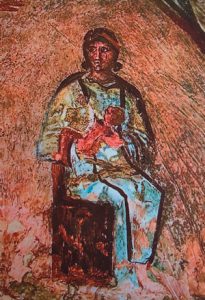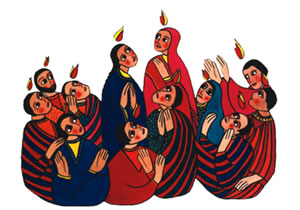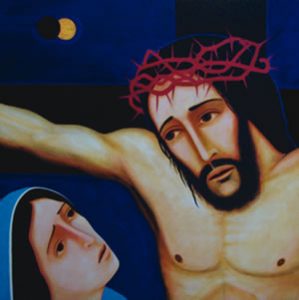Mary for Today – Part 6

by Br Kieran Fenn fms
Mary in Paul and Mark
The Beginnings: It is in the New Testament that we find the beginnings of Christian reflection on Mary; it is important to insist that these are the beginnings and not the fullness of Marian teaching and practice which has developed over the centuries. The earliest reference from the mid-fifties to the Mother of Jesus is found in Paul’s Letter to the Galatians:
“But when the time had fully come, God sent forth his Son, born of a woman, born under the law.” (Gal 4:4).

Image of Mary in the Catacomb of Priscilla
Little can be said for a Marian interpretation of this passage, but a basic affirmation is made: at the beginning of Jesus’ life there was a woman, his mother. Paul’s interest is to indicate that Jesus was authentically Jewish and human, as communicated through a Jewish mother. The Christology of the passage is the profound centre of the statement; its message about Mary is limited to the facts of her being a woman and a mother. As early as this passage a central point of Mariology is established: Any truth about Mary is first of all a truth about her Son.
Why her absence from the preaching of the apostles?
The apostles stick to the essentials: they were concerned to announce Christ, his passion and resurrection, his exaltation to God’s right hand and the salvation he brings.
Mary was still living; it was not fitting to speak of her.
Palestinian society was strongly patriarchal; it would not have been acceptable to speak of her.
The first generation had no idea of such issues as the virginal conception and assumption. The apostles knew only the adult Jesus, a prophet; they lived with him while he preached and worked miracles. They have no personal memory of the childhood of Jesus. Curiosity about his birth and childhood comes much later; the Infancy Narratives are the last part of the Gospels to be written. It is the Passion and Resurrection that are first.
It was the resurrection that posed the question. “Who is this Jesus?” The answer eventually takes two Gospel writers back to the infancy and birth and conception, and one to the pre-existence of the Word. It is in this context that Mary was presented in the late stages on the development of the NT.

Mary with the Apostles at Pentecost
Mary In Mark: (Mk 3:20-21, and 31-35). The mother of Jesus is in all four Gospels, but they present four quite distinct pictures. The gospels have distinctly different views of Mary, reflecting the evangelists’ diverse theologies of world history and understandings of Jesus, and the needs of the local churches for which they wrote. In Mark we have just the faintest outline; Matthew gives us a slightly stronger sketch; in Luke and John we have a vivid painting or full-bodied sculpture of the woman, disciple and mother. In no Gospel is Mary the dominant figure; always she is presented as being in some relationship with her Son. That is her role, not as an end herself, but as a pointer to her Son. What is fascinating about Mary and her role in our salvation story is the significant development in the appreciation of her by the various Gospel communities of later times.
Not a Popular Beginning: The temptation is often to bypass Mark to get on to the more flattering texts. The earliest Christian tradition on Mary is the story of the visit of the mother and brothers (Mk 3:31 to 35). This is not one of the more popular Marian texts; it seems to cast Mary in a negative light and embarrasses those who are devoted to her. If all we had was the Markan Gospel, we would have the name of the mother from 6:1-6a, two negative stories of rejection, and no deep devotion to Mary as integral to Catholic Christianity.
What is Mark doing? The Gospels cover a passage of over 60 years; earlier traditions are modified, and understood in a better way. The text on the family of Jesus asserts that it is open to every human being, a family not limited by blood, tribe, nation, colour, or culture; in this family there is a place for each one. And in this family there could be mother, brother, sister for Jesus, (but not Father!! V.35). Mark’s primary intention is not to say anything about Mary; it is to cast Jesus’ words in as strong a light as possible. This is best done by powerfully contrasting the two families. Mary was probably not known to Mark and his community; with so few references it is unlikely Mary was a significant figure in the early Markan church. The main point is not that Jesus did not care for his mother; he did. The point being made is that to belong to Jesus in relationship depends on the faith of a disciple; it does not depend on blood. Affection for his mother is not the issue; discipleship is!
We need to appreciate the overall perspective of Mark. In this Gospel everybody fails Jesus - his disciples, his people, his family. He dies with that terrible cry of abandonment: “My God, my God, why have you forsaken me?” We know Psalm 22 begins with that line but ends on a positive note; but let us not rush to that point until we recognize that in Mark, Jesus dies in utter desolation, without any relieving features at all. Jesus’ isolation could go no further: deserted by his disciples, taunted by his enemies, derided by those crucified with him, misunderstood by his family, suffocating in the darkness of evil. But the worst is now: feeling even abandoned by God. At least his mother and brothers are in good as well as bad company!

by Michael D O’Brien
Mark’s Second Reference: The story of Jesus’ unhappy return to his own home town results in the villagers taking offence at him, and speaking of his relatives and family identity. It is stated that he is son of Mary, brother to James, Joses, Judah, Simon, and his sisters are still there among the people. The son of Mary seems too familiar a figure to them to be of any religious significance. Sadly, the villagers ask the right question: “Where did this man come from or get all this learning?” But they give the wrong answer. They think they know the source of his power and authority because they know his earthly origins. What they miss is the faith dimension that is part of being a disciple; it is not enough to know the Son of God only as the son of Mary.
Augustine was to add an important comment to these Markan scenes when he reminded us that: “For Mary, it was a greater thing for her to have been Jesus’ disciple than to have been his mother.” Discipleship is a matter of faith rather than the natural relationship of family, an important issue in those early days when becoming a Christian could and did lead to family division (see 13:12).
References: Maloney, F. J. ‘Mary, Woman and Mother’.
Brennan, W. ‘The Sacred Memory of Mary.
 Entries(RSS)
Entries(RSS)